Abstract
The treatment of polluted industrial flow remains a relevant topic for the purpose of sustainable development and improvement of the general state of the environment. The removal of particulate matter, and especially their fine and ultra-fine fractions, from the gas flow, is an urgent task, but it poses many challenges and demands for purification technology. This paper presents the results of the first stage of the research using a newly developed cleaning device operating by a complex principle, which consists of a new generation two-stage centrifugal filtration device and an electro-filter. The rate of air flow was varied from 0.3 to 1.16 m/s at the inlet and corresponds to an air flow yield of 53 m3/h to 205 m3/h. The maximum pressure drop at an air flow of 255 m3/h is 26 Pa. Research has shown that the efficiency of removing ultra-fine particulate matter is up to 99.7% for particles 0.3–0.5 µm in size at 200 m3/h of the air flow rate.
1. Introduction
Particulate matter emissions are one of the most pressing problems, and their size is growing. In order to achieve ever higher air quality standards, additional attention is paid to the characteristics of particulate matter pollution [,]. Particulate matter less than 5 μm in diameter (fine particulate matter (FPM)) is very harmful to human health because it readily enters and accumulates in the lungs and respiratory tract. Long-term exposure to dusty air inhalation results in damage to the respiratory tract. Pollutants affect not only lung tissue but also the entire human body, so a person can develop pneumoconiosis and so on, and can cause eye and skin damage [].
Air pollution is a growing concern due to its harmful effects on human health and the environment. One of the most significant contributors to air pollution is ultrafine particulate matter, which can penetrate deep into the lungs and cause various health problems. Electro cyclone-filters have recently emerged as a promising technology for the removal of ultrafine particulate matter from gas streams. In this study, we investigate the gas flow parameters and fractional removal efficiency of a newly developed electro cyclone-filter. The study aims to understand the performance of the filter and optimize its design for better efficiency. To achieve this goal, we used numerical simulations and experiments to analyse the flow dynamics of the gas stream and the removal efficiency of the filter. This study contributes to the development of advanced air pollution control technologies and provides valuable insights for the design and optimization of electro cyclone-filters. The study draws on recent research in the field of fluid dynamics and environmental engineering, including references such as [,,,,,].
Gas stream cleaning technologies are applied according to the characteristics of the contaminants and the parameters of the installation process line. Many configurations include conventional cyclone-type devices that are as efficient as 90 percent for particles smaller than 5 microns [,]. The installation of an electrostatic apparatus is exclusively suitable for fine cleaning or recovery part of the process; however, it has many limitations as an independent device, and operation of the electrical system requires special competence [,,].
A multi-channel cyclone has been used relatively recently for the effective cleaning of polluted gas flows from high concentrations of coarsely dispersed particulate matter. However, the centrifugal forces used in the cyclone are not sufficient to settle the finely dispersed particulate matter moving in the turbulent air flow. Finely dispersed particulate matter is effectively cleaned using electrostatic air cleaning filters [,,,]. However, electrostatic filters that can work in the high concentration range, due to the large distance between the charging and deposition electrodes, are bulky and, therefore, not suitable for small flows and mobile devices [,,]. There are studies on the application of traditional treatment plants in the purification of a gas flow with specific surrounding conditions and particle agglomeration, which complicates the maintenance of such technologies [,,]. By exploiting the positive properties of the multi-channel cyclone and the electrostatic filter, effectively using them as prerequisites for improving both purification principles, it is possible to create an apparatus to effectively precipitate high-concentration coarse–dispersed particulate matter. The multi-channel cyclone reduces the load on the electrostatic filter by collecting most of the particulate matter. Electrostatic filters with a reduced gap between the charging and deposition electrodes can then be used to clean slightly polluted air. This assumption makes it possible to reduce the size of the electrostatic filter, making it acceptable to a much wider range of users. When the component of the tangential air flow rate is properly used after leaving the multi-channel cyclone, it helps to align it according to the direction with the movement of the charged particle in the electric field of the electrostatic filter. It is possible to increase the rate of movement of the charged particle in the electric field while reducing the settling time.
The degree of purification of the gas stream using traditional methods does not allow the required level of purification. More and more works are presented for particulate matter capture. One part of the work is directed to the purification of contaminated gases from power sources, both on a large and small scale. For example, emissions from different types of boilers for burning solid fuels are studied. Flow dilution technologies are studied to reduce the concentration of particulate matter []. There are scientific works in which liquid fuels from renewable sources are also used. Experimental data have been obtained under domestic conditions in the combustion of edible oil [].
The study of electrostatic filters is particularly common due to the large number of variations when the electric field characteristics change, as well as in the study of particle accumulation and agglomeration.
As mentioned earlier, to achieve high efficiency and reduce to the necessary levels of particulate matter concentrations, it is necessary to use several methods by principle of operation, which can be coordinated with each other. Such a process has been studied using dry and wet cleaning, as well as the introduction of additional elements acting on the pollutants in the gas stream. As a basis, it is assumed that the primary purification is necessary to reduce the load on all subsequent stages. In subsequent stages, they can be used as fibre filters [] and apparatuses with liquid solutions that spray this reagent into the gas stream []. In all cases, it is necessary to provide the limitations applied to each of the methods, in order not to aggravate the situation and not to create secondary contamination.
This work is dedicated to the initial stage of research to create a new design of air cleaning device for fine- and ultra-fine particulate matter that is suitable for use in a wide range of concentrations, working conditions, chemical-physical nature, and dispersion composition of these particles.
Overall, the study provided valuable information on the gas flow parameters and fractional removal efficiency of the newly developed ECF system for ultrafine PM removal and its potential applications for air pollution control.
The purpose of this work is to carry out the initial testing of the experimental bench and to study the aerodynamic parameters, such as air flow rate and pressure loss in the system, and to determine the efficiency of removing individual fractions of ultra-fine particulate matter for further analysis of this apparatus.
2. Materials and Methods
Based on the results of previous studies [,], a model of a multi-channel spiral cyclone-electrostatic filter was developed. The initial version of the mock-up was produced under laboratory conditions to study the flow characteristics of the gas flow and the fractional trapping efficiency of the particles. The main part of the device is shown in Figure 1. Only a schematic diagram of the device is provided, which describes the operation, as a European patent application is being prepared for this device, which will be submitted for consideration in the near future.
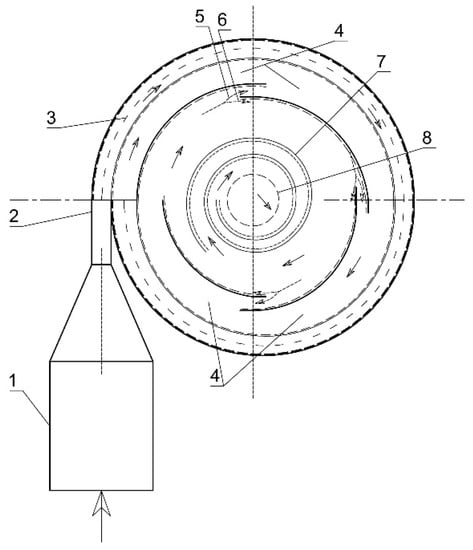
Figure 1.
Schematic diagram of an electro cyclone-filter equipped with (1) inflow pipe, (2) inlet to the cyclone channel, (3) centrifugal settling zone, (4) multi-channel cyclone-filter zones bounded by curvilinear elements, (5) peripheral gas flow, (6) transit gas flow, (7) electrostatic deposition zone, (8) cleaned air duct.
The experimental stand of an electro cyclone-filter consists of a centrifugal fan of variable capacity with a precise frequency converter connected in series with the gas flow inlet pipe. The particulate matter is injected into the gas inlet pipe by an automatic dosing dispenser. The gas flow enters through the confuser into the cyclone primary channel in the centrifugal separation zone. The flow makes a full lap before flowing into the multi-channel cyclone-filter zone, which is made from the closed contour (channel) by the elements of semi-rings. The flow moves around the deposition contour and divides into peripheral and transitional flow at the edge of each element of semi-ring. The primary (centrifugal) and secondary (multi-channel) separation chambers of the cyclone precipitate the particulate matter by centrifugal forces and the centrifugal-filtration phenomenon accordingly, and the particulate matter goes down through the slits in the bottom to the apparatus hopper for accumulation (Figure 1 and Figure 2).
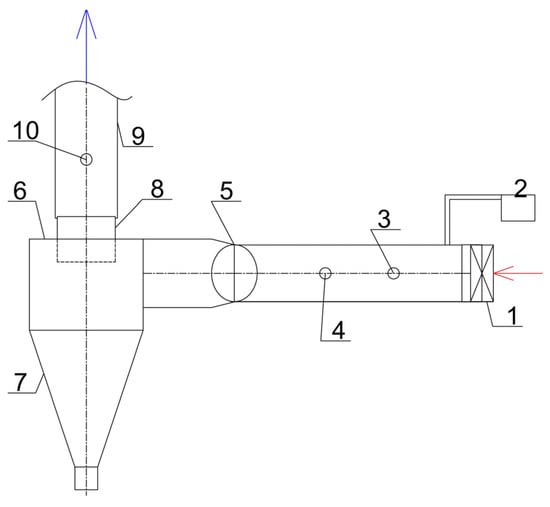
Figure 2.
An experimental electro cyclone bench with (1) air flow fan, (2) particle dispenser, (3) air flow rate/pressure test point in the contaminated flow duct, (4) particle number concentration point in the duct, (5) duct transition to mixer, (6) cyclone-filter part of the purifier, (7) hopper of the purifier, (8) electrostatic filter part of the purifier, (9) outlet duct of the purified air, (10) test point of the air flow rate/pressure of the contaminated in the flow duct.
In experimental studies, the following equipment was used to study gas flow dynamics: gas flow rate and static pressure are determined by thermocouples, Testo (Testo SE & Co. KGaA, Titisee-Neustadt, Germany), range of rate measurements: 0.01–30 m/s, deviation ± 0.05 m/s, and a differential pressure gauge DSM-1 (JSC Teltonika, Vilnius, Lithuania), range of measurements: 0–20,000 kPa; deviation ± 5 Pa.
A concentration of each fraction of particulate matter was performed using a numerical particle counter (Fluke 985). The fraction levels were determined in six size ranges: less than 0.3 µm, 0.5 µm, 1.0 µm, 2.0 µm, 5.0 µm, and 10.0 µm.
The sampling rate is 0.1 cfm (2.83 L/min). The device counting efficiency is 50% for particles of 0.3 µm size and 100% for >0.45 µm size particles. Zero count level is equal to 1 count/5 min. The results were repeated until there was a repeatability and a difference between the minimum and maximum of no more than 5%.
Each test was carried out under the same meteorological conditions, placing the measuring equipment at significant points according to the diagrams in Figure 2. The concentration determination was based on a class 3B laser source with a wavelength of 775–795 nm and a power of 90 mW. The efficiency of the calculations was based on ISO 21501, that is, a 50% probability for particles with a size of 0.3 µm were determined with a 100% probability for more than 0.45 µm.
A Palas RGB 1000 mobile particulate generator was chosen as the regulated particulate source. The device was used to set the parameters for the aerosol feeding in the air duct immediately after the fan was pushed toward the cleaning apparatus. Glass particles were used in the study. To calibrate particle emission, the speed of the working drum rpm, and the feed corkscrew, and the compressor pressure was equal to 3 bar. The average inlet concentration of particulate matter in the gas flow was 5.4 µg/m3.
To calculate the mass concentration (C) in kg/m3 of particulate matter, a conversion of the numerical concentration of particles was used in accordance with Equation (1):
where N is the number of aerosol particles of a given size in m3 of air volume; by default this volume is equal to 1 m3. ρ is the particle density in kg/m3, the density of glass particles is assumed to be 1500 kg/m3, and R is the particle radius, m, for each case; this radius in µm is equal to 0.3, 0.5, 1.0, 2.0, 5.0, and 10.0.
An experimental mock-up bench with test points for aerodynamic parameters and particulate matter concentration tests is provided in Figure 2.
In the first stage of the investigation, studies of the aerodynamic parameters of the flows were carried out in the presence of only part of the electrostatic filter. Studies of the air flow rate generated by the installed tubular fan and the distribution of air flow rate in the duct at different fan rates (from 10 Hz to 20 Hz) were performed.
The aim of these studies was to determine the optimal conditions for uniform distribution of the flow throughout the cross-section and to achieve a suitable air flow rate for ionizing and settling particulate matter in the installed electrostatic filter, and thus removing them from the polluted air flow. In the second stage, the centrifugal and multi-channel cyclone-filter part was connected in series with the electrostatic filter part to study the aerodynamic parameters and the settling efficiency of individual fractions of particulate matter.
3. Results
3.1. Aerodynamic Research in Apparatus System
In the first stage, the air flow rate was investigated only in the section of the electrostatic filter. It is known that the optimal rate of gas movement into this type of filter must be about 1 m/s in order to achieve a suitable rate of movement of the particles to electrify them and settle on the deionizer. In addition, flow-equalizing grids were installed in the duct, thus achieving an even distribution of air flow in the cross-section. Air flow rate was: in the periphery 0.30–1.16 m/s (gas flow rate from 53 to 205 m3/h), and in the centre, 1.08 m/s (gas flow rate 190 m3/h and more). The rate of air flow at the outlet changed, and reached: in the periphery 1.31–1.90 m/s (gas flow rate from 231 to 335 m3/h), and in the centre, 0.47 m/s (83 m3/h). The average gas flow rates were approximately: inlet—150 m3/h, outlet—215 m3/h. In this case, the average air flow rate in a single electrostatic deposition zone reached 1.04 m/s, which satisfies the conditions. At different fan speeds in the range of 10–20 Hz, the aerodynamic drag varied from 2 Pa to 26 Pa; in the optimal case (15 Hz), the aerodynamic drag reached 11 Pa. The recalculated air flow rates at the fan rate are: 10 Hz—55 m3/h, 12 Hz—103 m3/h, 15 Hz—165 m3/h, 18 Hz—218 m3/h, 20 Hz—255 m3/h.
In the second stage, both parts of the device, the cyclone and the electrostatic filter of both zones, were connected in series and installed on a common experimental bench. The obtained research results are presented in Figure 3.
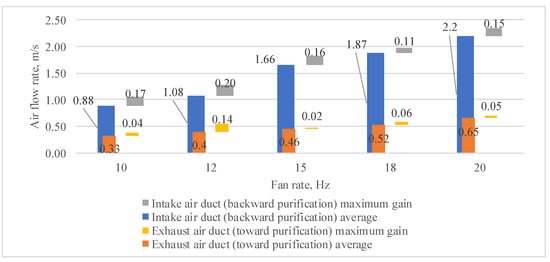
Figure 3.
Variation of the air flow rate depending on the fan rate in the intake and exhaust air ducts.
3.2. Finely Dispersed Particulate Matter Removing Efficiency
In the third stage of the investigation, the efficiency of removing finely dispersed particulate matter from the air was evaluated. Particle number concentrations were analysed in the inflow and outflow using a particle counter. Irrespective of the optimal case determined, when evaluating the aerodynamic parameters, the cases were studied at different fan speeds, that is, for the flow rate of the supplied air stream, and also in the case of different contamination of the supplied air flow with particulate matter before the cleaning device.
At the optimal flow rate of the air flow (fan rate 15 Hz), we evaluated the concentrations of particulate matter in the entire cross-section (5 points). In other cases of the study, the results obtained are presented in Figure 4.
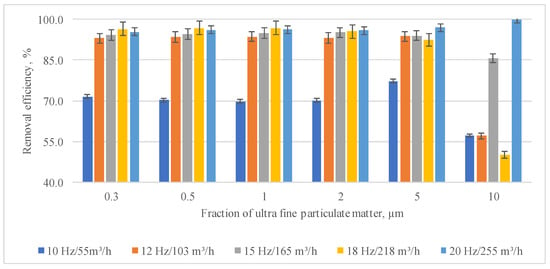
Figure 4.
Dependence of the removal efficiency of the apparatus on the fraction of ultra-fine particulate matter in different cases of fan rate and air flow rate.
The fractional efficiency of particulate matter sedimentation showed specific tendencies of the purification process. According to the particle matter removal values, it can br clearly seen that, at a flow rate of 55 m3/h, there is unfinished sedimentation, and, in this case, the size of the particles does not matter. However, even in this case, the removal efficiency varies in the range of 57–77%. Increasing the gas flow rate by slightly less than twofold affected the removal efficiency of particulate matter by more than 2.5 times on average. This trend was maintained to an air flow of 255 m3/h. In some cases, for example, for particles of 5 µm at a gas flow rate that changed from 165 m3/h to 218 m3/h, efficiency values decreased, but not by more than 2%. When looking at the removal data of 10 µm particulate matter, the data changed quite critically, due to the very small count of particles in the clean gas flow. Thus, even a single particle would change the removal efficiency by several tens of percent. Considering all research cases only from the point of view of cleaning efficiency, the priority variant corresponds to the nominal fan capacity, that is, at the flow rate of 255 m3/h. However, when evaluating the optimal mode under real operating conditions, it is necessary to take into account energy costs and the uniformity of catching particles for all fractions.
The following deposition efficiency was achieved: for particles of 0.3 µm size—96.5%, 0.5 µm—96.8%, 1.0 µm—96.8%, 2.0 µm—95.5%, 5.0 µm—92.3%, and 10.0 µm—50.0%. In this case, the number of particles with a size of 0.3 µm before cleaning reached an average of 43,742 pieces. After cleaning, there were 1546 pieces, and 5 µm particles totaled 17.3 pieces and 1.3 pcs., respectively.
In evaluating the average removal efficiency of particulate matter, the 165 m3/h and 255 m3/h versions differ by 3%, with the latter having a value of 96.7 percent. In the closest other cases, the average efficiency is reduced by more than 10%, and in the case at 55 m3/h, the average efficiency is just under 70%.
The removal efficiencies of ultrafine particulate fractions are: 0.3 µm—from 71.5% to 99.7%, 0.5 µm—from 70.3% to 96.0%, 1.0 µm—from 69.8% to 96.2%, 2.0 µm—from 70.2% to 95.1%, 5.0 µm—from 77.3% to 96.9%, 10 µm—from 57.1% to 97.2%.
4. Discussion
As expected, the optimal application case for the complex device was up to 15 Hz when the flow rate of the outgoing flow was not higher than 0.5 m/s, which, considering the resistance, did not exceed the allowed rate in the electrostatic filter above 1 m/s (Figure 5). Aerodynamic resistance values, even at the highest selected fan rate (20 Hz), did not exceed 90 Pa, which is rational and a great advantage compared to other cleaning devices of similar performance, considering the energy consumption for air cleaning using this device.
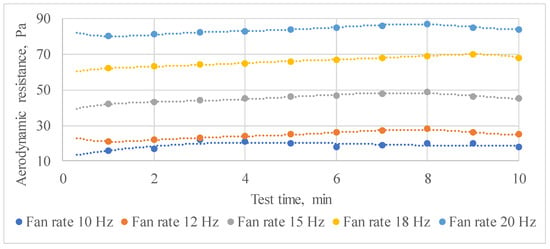
Figure 5.
Dependence of the aerodynamic resistance of the apparatus on the fan rate during the test time rate.
As mentioned earlier in the description of the results, other characteristics should also be taken into account when evaluating the different modes of operation of the cleaning technologies in their actual operation. Among such characteristics, one of the most important, the static pressure drop in the system after the gas flow purification apparatus, is usually presented as aerodynamic resistance. Its smallest value helps to save a significant part of the energy of the flow, so, in this case, the consumption of electricity will be minimal. However, the reduction of resistance is often controlled by reducing the velocity of the gas flow in the apparatus, which uses the principles of the centrifugal method and leads to a decrease in the efficiency of particle collection. Thus, it is necessary to evaluate the balance of such reciprocal parameters as capture efficiency and aerodynamic resistance. Recently, it has been generally accepted that different types of filters should not create more resistance to flow than 50 Pa, which is especially important in the green course, including reducing energy consumption in processes. In this study, in three out of five cases, the pressure drop did not exceed 50 Pa for 10 min of the study. Therefore, these options can be considered an energy priority, which may not have anything to do with cleaning efficiency. Therefore, it is worth deciding, on a case-by-case basis, what to prioritize from the perspective of who will operate the technology.
The results showed that the existing model design is promising for further scientific evaluation. The efficiency of removal of ultra-fine fractions of particles from the air flow reaches approximately 70%, and the average value of the removal efficiency of finely dispersed particles from 1 µm to 10 µm in size reaches more than 85%. In the cleaned air stream, the fraction of particles reached the value calculated from the numerical concentration: 0.3 µm—0.58 µg/m3, 0.5 µm—0.37 µg/m3, 1.0 µm—0.97 µg/m3, 2.0 µm—1.71 µg/m3, 5.0 µm—2.0 µg/m3 and 10 µm—0.55 µg/m3.
The results of the deposition prove the distribution of the optimal flow rate in air volumes ranging from 165 m3/h to 255 m3/h. However, particularly fine particles are characterized by the fact that a flow rate above 0.52 m/s reduces their trapping. This is because there is insufficient time for the particle to be in the ionization zone and because the particle with a small charge flies past the deposition electrode and is not captured. Another reason may be the secondary entrainment of particles from the deposition electrode itself as a result of the dynamic flux force exceeding the sum of electric and adhesion forces of the particle with the electrode surface.
This initial phase of research allowed us to study the cases of aerodynamic parameters and the achievable removal efficiency of individual fractions of particulate matter. In future work, research will be carried out focussing on particles of different natures, and not only aerodynamic but also electrostatic parameters of the experimental stand will be controlled. These results will allow the cleaning process to be managed in a complex manner and achieve greater cleaning efficiency by selecting optimal work indicators.
5. Conclusions
The intermediate results obtained allowed the installation of an experimental stand for preliminary research. The design of the air cleaning device was tested in preliminary studies, the characteristic aerodynamic parameters were determined, and the control system was installed. The results obtained allowed us to determine the optimal cases for the application of the air cleaning device. The latter cases, as the main ones, will be tested as essential to minimise research time and pay more attention to the evaluation of the characteristics of the pollutant, the deposition process, and the applications possibilities.
- The optimal fan rate was 15 Hz, which corresponds to an air flow of 165 m3 per hour.
- The pressure drop does not exceed 90 Pa at a flow rate in the inlet air duct of 2.35 m/s; when the rate drops to 1.70 m/s (fan rate 15 Hz), the pressure drop is 46 Pa.
- The optimal flow rate in the inlet air duct for the deposition of ultra-fine particulate matter is 1.90 m/s, at which particles of 0.3–0.5 µm in size are captured with an efficiency of more than 96.5%.
- The average efficiency of trapping particles of sizes 0.3 µm to 10 µm at optimal flow parameters exceeds 93%.
Author Contributions
Conceptualization, A.C., A.K.; methodology, A.C., A.K.; software, A.C., A.K.; validation, A.C., A.K.; formal analysis, A.C., A.K.; investigation, A.C., A.K.; resources, A.C., A.K.; data curation, A.C., A.K.; writing—original draft preparation, A.C., A.K.; writing—review and editing, A.C., A.K.; visualization, A.C., A.K.; supervision, A.K., A.C. All authors have read and agreed to the published version of the manuscript.
Funding
This research received no external funding.
Institutional Review Board Statement
Not applicable.
Informed Consent Statement
Not applicable.
Data Availability Statement
Not applicable.
Acknowledgments
This project has received funding from the Research Council of Lithuania (LMTLT), agreement No [S-PD-22-31].
Conflicts of Interest
The authors declare no conflict of interest.
References
- Lighty, J.S.; Veranth, J.M.; Sarofim, A.F. Combustion Aerosols: Factors Governing Their Size and Composition and Implications to Human Health. J. Air Waste Manag. Assoc. 2000, 50, 1565–1618. [Google Scholar] [CrossRef]
- Bessou, C.; Ferchaud, F.; Gabrielle, B.; Mary, B. Biofuels, Greenhouse Gases and Climate Change. A Review. Agron. Sustain. Dev. 2011, 31, 1–79. [Google Scholar] [CrossRef]
- Oliveira, M.L.S.; Navarro, O.G.; Crissien, T.J.; Tutikian, B.F.; da Boit, K.; Teixeira, E.C.; Cabello, J.J.; Agudelo-Castañeda, D.M.; Silva, L.F.O. Coal Emissions Adverse Human Health Effects Associated with Ultrafine/Nano-Particles Role and Resultant Engineering Controls. Environ. Res. 2017, 158, 450–455. [Google Scholar] [CrossRef] [PubMed]
- Yang, C.; Zhang, J.; Huang, Z. Numerical Study on Cavitation–Vortex–Noise Correlation Mechanism and Dynamic Mode Decomposition of a Hydrofoil. Phys. Fluids 2022, 34, 125105. [Google Scholar] [CrossRef]
- Bai, B.; Bai, F.; Sun, C.; Nie, Q.; Sun, S. Adsorption Mechanism of Shell Powders on Heavy Metal Ions Pb2+/Cd2+ and the Purification Efficiency for Contaminated Soils. Front. Earth Sci. 2023, 10, 1071228. [Google Scholar] [CrossRef]
- Guo, Z.; Zhan, R.; Shi, Y.; Zhu, D.; Pan, J.; Yang, C.; Wang, Y.; Wang, J. Innovative and Green Utilization of Zinc-Bearing Dust by Hydrogen Reduction: Recovery of Zinc and Lead, and Synergetic Preparation of Fe/C Micro-Electrolysis Materials. Chem. Eng. J. 2023, 456, 141157. [Google Scholar] [CrossRef]
- Liu, Y.; Li, B.; Lei, X.; Liu, S.; Zhu, H.; Ding, E.; Ning, P. Novel Method for High-Performance Simultaneous Removal of NO and SO2 by Coupling Yellow Phosphorus Emulsion with Red Mud. Chem. Eng. J. 2022, 428, 131991. [Google Scholar] [CrossRef]
- Chen, B.; Lu, Y.; Li, W.; Dai, X.; Hua, X.; Xu, J.; Wang, Z.; Zhang, C.; Gao, D.; Li, Y.; et al. DPM-LES Investigation on Flow Field Dynamic and Acoustic Characteristics of a Twin-Fluid Nozzle by Multi-Field Coupling Method. Int. J. Heat Mass Transf. 2022, 192, 122927. [Google Scholar] [CrossRef]
- Li, Z.; Wang, K.; Li, W.; Yan, S.; Chen, F.; Peng, S. Analysis of Surface Pressure Pulsation Characteristics of Centrifugal Pump Magnetic Liquid Sealing Film. Front. Energy Res. 2022, 10, 937299. [Google Scholar] [CrossRef]
- Sati, V.; Kaushik, S.; Kshetri, R.; Panwar, K.; Pandey, R. Comparison of a Classical Cyclone Separator and Protruding Surface Cyclone Separator Using CFD Software. IOP Conf. Ser. Mater. Sci. Eng. 2020, 802, 12008. [Google Scholar] [CrossRef]
- Honda, A.; Okuda, T.; Nagao, M.; Miyasaka, N.; Tanaka, M.; Takano, H. PM2.5 Collected Using Cyclonic Separation Causes Stronger Biological Responses than That Collected Using a Conventional Filtration Method. Environ. Res. 2020, 198, 110490. [Google Scholar] [CrossRef] [PubMed]
- Bekkara, F.M.; Benmimoun, Y.; Kheiter, A.; Chelih, A.; Tilmatine, A. Electrostatic Charge Decay and Filtration Performance of Nonwoven Filters in the Vicinity of Grounded Metal Grids. J. Electrost. 2021, 110, 103554. [Google Scholar] [CrossRef]
- Feng, Z.; Long, Z.; Mo, J. Experimental and Theoretical Study of a Novel Electrostatic Enhanced Air Filter (EEAF) for Fine Particles. J. Aerosol Sci. 2016, 102, 41–54. [Google Scholar] [CrossRef]
- Gajbhiye, N.; Eswaran, V.; Saha, A.K.; Kumar, A. Numerical Calculation of Particle Collection Efficiency in an Electrostatic Precipitator. Sadhana 2015, 40, 863–873. [Google Scholar] [CrossRef]
- Guo, B.; Yu, A.; Guo, J. Numerical Modelling of ESP for Design Optimization. Procedia Eng. 2015, 102, 1366–1372. [Google Scholar] [CrossRef]
- Li, S.; Zhang, S.; Wuxuan, P.; Long, Z.; Tao, Y. Experimental and Theoretical Study of the Collection Efficiency of the Two-Stage Electrostatic Precipitator. Powder Technol. 2019, 356, 1–10. [Google Scholar] [CrossRef]
- Salleh, S.; Khan, A.; Nolasco-Hipolito, C.; Kinidi, L.; Herdawati, D.S. An Analytical Modeling Approach for Performance Evaluation of Electrostatic Precipitator (ESP). J. Energy Saf. Technol. (JEST) 2019, 1, 63–73. [Google Scholar] [CrossRef]
- Zheng, C.; Shen, Z.; Yan, P.; Zhu, W.; Chang, Q.; Gao, X.; Luo, Z.; Ni, M.; Cen, K. Particle Removal Enhancement in a High-Temperature Electrostatic Precipitator for Glass Furnace. Powder Technol. 2017, 319, 154–162. [Google Scholar] [CrossRef]
- Nouri, H.; Zouzou, N.; Dascalescu, L.; Zebboudj, Y. Investigation of Relative Humidity Effect on the Particles Velocity and Collection Efficiency of Laboratory Scale Electrostatic Precipitator. Process Saf. Environ. Prot. 2016, 104, 225–232. [Google Scholar] [CrossRef]
- Yan, J.; Wang, H.; Zheng, Y.; Huang, X.; Meng, H.; Tan, C. A Novel Dew Point Measurement System Based on the Thermal Effect of Humidity Sensitive Thin Film. Measurement 2022, 187, 110248. [Google Scholar] [CrossRef]
- de Sarabia, E.R.-F.; Elvira-Segura, L.; González-Gómez, I.; Rodríguez-Maroto, J.J.; Muñoz-Bueno, R.; Dorronsoro-Areal, J.L. Investigation of the Influence of Humidity on the Ultrasonic Agglomeration of Submicron Particles in Diesel Exhausts. Ultrasonics 2003, 41, 277–281. [Google Scholar] [CrossRef] [PubMed]
- Abdul-Khalek, I.; Kittelson, D.; Brear, F. The Influence of Dilution Conditions on Diesel Exhaust Particle Size Distribution Measurements. J. Fuels Lubr. 1999, 108, 563–571. [Google Scholar]
- Chlebnikovas, A.; Selech, J.; Kilikevičius, A.; Przystupa, K.; Matijošius, J.; Vaišis, V. Modeling of Two-Phase Flow Parameters of a Multi-Channel Cylindrical Cyclone. Energies 2022, 15, 4690. [Google Scholar] [CrossRef]
- Poongodi, K.; Murthi, P. Development of Fibre Reinforced Green Mortar Made with Waste Brick Material as Fine Aggregate for Sustainable Masonry Construction. Mater. Today Proc. 2022, 68, 1575–1580. [Google Scholar] [CrossRef]
- Agbadede, R.; Pilidis, P.; Igie, U.L.; Allison, I. Experimental and Theoretical Investigation of the Influence of Liquid Droplet Size on Effectiveness of Online Compressor Cleaning for Industrial Gas Turbines. J. Energy Inst. 2015, 88, 414–424. [Google Scholar] [CrossRef]
- Chlebnikovas, A.; Jasevičius, R. Investigation of the Interaction of Particulate Matter and Its Separation from the Gas Flow in a Multi-Channel Cyclone with Recirculation. Granul. Matter 2022, 24, 98. [Google Scholar] [CrossRef]
Disclaimer/Publisher’s Note: The statements, opinions and data contained in all publications are solely those of the individual author(s) and contributor(s) and not of MDPI and/or the editor(s). MDPI and/or the editor(s) disclaim responsibility for any injury to people or property resulting from any ideas, methods, instructions or products referred to in the content. |
© 2023 by the authors. Licensee MDPI, Basel, Switzerland. This article is an open access article distributed under the terms and conditions of the Creative Commons Attribution (CC BY) license (https://creativecommons.org/licenses/by/4.0/).